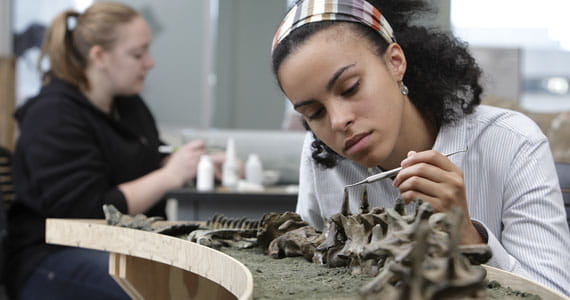Field Work and Research

When it comes to field work and research, our biology students aren't afraid to get a little dirty. Aja Carter has been uncovering bones for years. She went to Montana during her junior year of high school to work on a Triceratops skull and Tyrannosaurus rex fragments. As a pre-junior Biology major with a paleobiology concentration, she found fossils in Drexel's dig site at a marl pit in Sewell, New Jersey. Graduate and undergraduate students use the site from spring until November. "Every Friday we get to go into the field and come out dirty, and that is the best feeling in the world," Aja says.
While the marl pit in New Jersey has yet to yield dinosaur remains, the team found many specimens from the end of the Cretaceous period, including mosasaurs, plesiosaurs, turtles, and fish with fangs. The large number of fossils found, and the location of the fossils — all within a three-inch layer — suggests that they all died at the same time and were quickly preserved, perhaps when a giant meteor hit the earth 65 million years ago and wiped out all life above ground. Aja and the team are explored this possibility through careful, thorough mapping, research, and testing, looking for indicators that would confirm the marl pit as the only identified site on Earth with a bone bed from the last day of the dinosaurs.
Regardless of the outcome, the site provides valuable field experience to complement the lab research that students are involved with on campus and at the Academy of Natural Sciences of Drexel University. Aja is thrilled to be working in this era, "All the questions that my predecessors couldn't answer, we're getting close to, which is really exciting. We're kind of coming up on the golden age of paleontology right now. It's awesome."
Bachelor's, PhD, and beyond, Aja is hoping to be able to go to Argentina or Spain — somewhere she can use her Spanish minor — to dig up dinosaurs. "My goal is to be six feet under — not dead — working with that stuff for the rest of my life."
To learn more about Drexel's cutting-edge research, visit our research page.